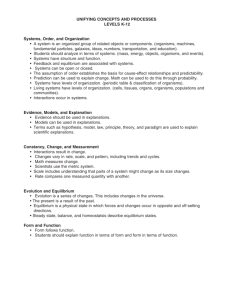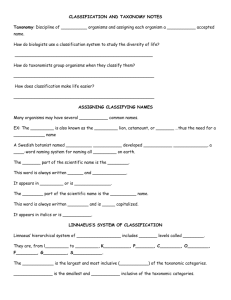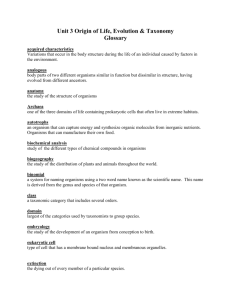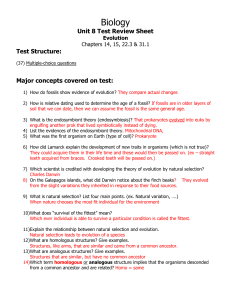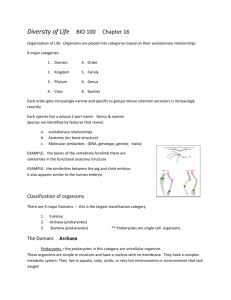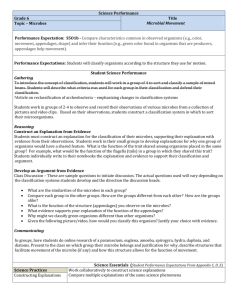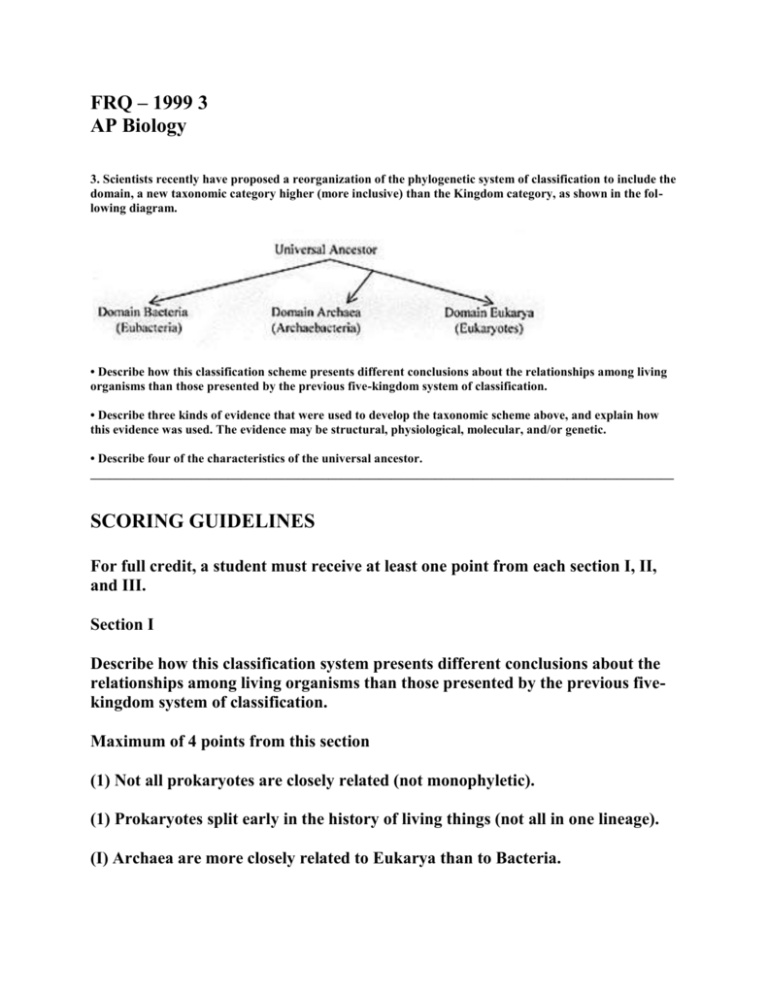
FRQ – 1999 3
AP Biology
3. Scientists recently have proposed a reorganization of the phylogenetic system of classification to include the
domain, a new taxonomic category higher (more inclusive) than the Kingdom category, as shown in the following diagram.
• Describe how this classification scheme presents different conclusions about the relationships among living
organisms than those presented by the previous five-kingdom system of classification.
• Describe three kinds of evidence that were used to develop the taxonomic scheme above, and explain how
this evidence was used. The evidence may be structural, physiological, molecular, and/or genetic.
• Describe four of the characteristics of the universal ancestor.
_____________________________________________________________________________________________
SCORING GUIDELINES
For full credit, a student must receive at least one point from each section I, II,
and III.
Section I
Describe how this classification system presents different conclusions about the
relationships among living organisms than those presented by the previous fivekingdom system of classification.
Maximum of 4 points from this section
(1) Not all prokaryotes are closely related (not monophyletic).
(1) Prokaryotes split early in the history of living things (not all in one lineage).
(I) Archaea are more closely related to Eukarya than to Bacteria.
(1) Eukarya are not directly related to Eubacteria.
(1) There was a common ancestor for all extant organisms (monophyletic).
(1) Eukaryotes are more closely related to each other (than Prokaryotes are to
each other)
(1) Correct description of the five-kingdom system.
Section II
Describe three kinds of evidence that were used to develop the taxonomic scheme
above, and explain how this evidence was used. The evidence may be structural,
physiological, molecular, and/or genetic.
Maximum of 6 points, 3 points from the first three descriptions of evidence
mentioned and 3 from the explanations. The explanations must differentiate
between at least two of the groups.
Description
Explanations
Eukaryotes
Differences
Habitat - mostly extreme (halophilic, thermophilic,
acidic)
Mitosis/meiosis
Reproduction
+
Multicellularity exists
+
Nucleus
+
Membrane-bound organdies
+
Microtubules/ microfilaments
Cell walls with peptidoglycan
Chromosomes:
Shapes
Namber
Histories present
Ribosomes: Size
Base sequence of rRNA
Structure of tRNA
RNA polymerase
Archaea
Eubacteri
+
Binary fission
Bina
-
Linear
More than
one
+
Circular
One
+
Large
Similar
Small
Similar
U
Similar
Unique
S
Multiple
types
Multiple
types
Sin
C
Introns
Operon organization of genes
Present
Some
-
+
Initiator amino acid in protein formation
Methionine
Methionine
Phospholipids: Bonds
Hydrocarbon structure
Can be pathogens
Response to antibiotics such as streptomycin or
chioramphenicol
Response to diphtheria toxins
Metabolism Can be methanogens
Enzymatic make-up differs
Enzyme location differs
Photosynthetic pigments differ
Differences in gene sequences of DNA
Differences in whole genome sequences
Ester
Unbranched
Ether
Branched
+
-
-
-
+
-
-
+
f
me
Un
Must correctly describe what the differ
Must correctly describe what the differ
Must correctly describe what the differ
Section III
Describe four of the characteristics of the universal ancestor.
Maximum of 4 points for this section. Described characteristics can earn one
point each OR one point may be earned for a list of the first four correct
characteristics.
Characteristic (possible explanations)
(1) Small (surface to volume ratio, no internal transport system)
(1) Unicellular (all functions self-contained)
(1) Prokaryote (no membrane-bound organelles).
(1) Had cell membrane (containment, protection, semipermeable)
(1) cell membrane made of a phospholipid bilayer (barrier).
(1) cytoplasm (different from external environment)
(1) DNA for the genetic material (or nucleic acid or RNA)
(1) mRNA for information transfer (common to all organisms)
(1) tRNA to carry amino acids and/or aminoacylsynthetase (common to all
organisms)
(1) ability to reproduce (asexual)
(1) ability to mutate, adapt, or evolve through natural selection
(1) ability to make proteins or had ribosomes on which proteins could be
constructed
(1) metabolism: carbon-based or organic; Energy transformations, ATP as
energy molecule
(1) enzymes for amino acid, nucleotide, and coenzyme synthesis as well as
enzymes for glycolysis and the Krebs cycle (common to all organisms)
(1) Heterotrophic/Autotrophic* with explanation (* not photosynthetic)
(1) Anaerobic/aerobic with explanation
(1) Aquatic with explanation
Copyright 2001 by College Entrance Examination Board. All rights reserved.
Advanced Placement Program and AP are registered trademarks of the College
Entrance Examination Board.

